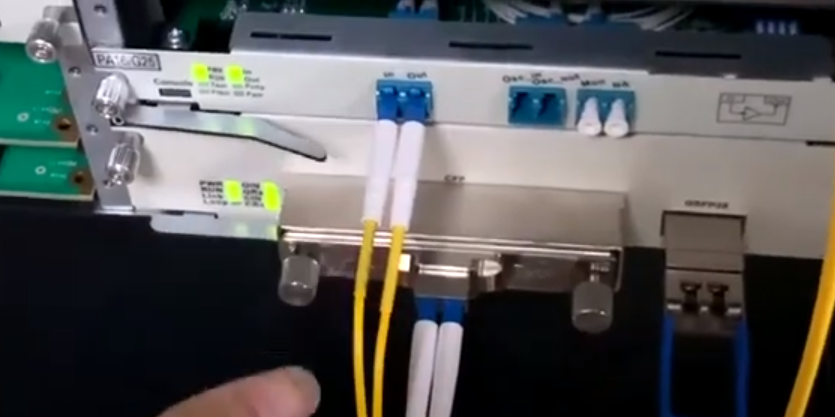Technology
Exploring the World of DWDM Fiber: A Comprehensive Guide

Dense Wavelength Division Multiplexing (DWDM) represents a pivotal advancement in fiber optic communication, enabling the simultaneous transmission of multiple data streams across a single optical fiber. By dividing the light into numerous distinct wavelengths, DWDM significantly enhances the bandwidth capacity of optical fiber cables, thus facilitating the high-speed transmission of vast amounts of data. This technology is instrumental in meeting the exponentially growing demands for telecommunications bandwidth, driven by data-intensive services such as cloud computing, high-definition video streaming, and the Internet of Things (IoT). In the ensuing sections, we will explore the fundamental principles of DWDM, its operational mechanics, key components, advantages over alternative technologies, and its critical role in both current and future telecommunication infrastructures.
What is DWDM Fiber and How Does it Work?
Understanding the Basics of DWDM Technology
Dense Wavelength Division Multiplexing (DWDM) is an optical multiplexing technology used to increase bandwidth over existing fiber networks. DWDM works by combining and transmitting multiple data signals simultaneously at different wavelengths on the same fiber. The core principle behind DWDM is that by dividing the light into several wavelengths or colors, a single optical fiber can be used to transport multiple streams of data independently. This multiplexing technique significantly expands the capacity of the fiber by allowing various digital signals (such as voice, data, and video) to be sent simultaneously, without interfering with each other.
Dense Wavelength Division Multiplexing Explained
At its heart, DWDM technology involves the use of a series of optical transmitters, each generating a light signal at a unique wavelength. These signals are then combined using a multiplexer and launched into the fiber. At the receiving end, a demultiplexer separates all the wavelengths and directs each channel to its respective receiver. The incorporation of optical amplifiers within the system can boost the signal, extending the reachable distance without degradation.
Key Components of a DWDM System
A comprehensive DWDM system comprises several critical components, each serving a distinct function. Some of the principal components include:
- Optical Transmitters/Transponders: These devices convert the input electrical signal into an optical signal at a specific wavelength.
- Multiplexers: Multiplexers combine optical signals from different transponders and send them over a single fiber.
- Optical Amplifiers: These are used to amplify the optical signal and ensure that it can travel long distances without significant loss.
- Demultiplexers: At the receiving end, demultiplexers separate the combined optical signals back into individual wavelengths.
- Optical Add/Drop Multiplexers (OADMs): OADMs are used to add or drop specific wavelength channels from a multi-wavelength DWDM signal.
- Optical Switches: These components facilitate network routing, allowing the optical paths to be dynamically adjusted.
Understanding each component’s role within the DWDM infrastructure is crucial for the design, implementation, and maintenance of a high-capacity and efficient optical communication network.
recommend reading: DWDM Technology: Its Development and Application
Difference Between CWDM and DWDM: Which One to Choose?
When comparing Coarse Wavelength Division Multiplexing (CWDM) with Dense Wavelength Division Multiplexing (DWDM), it’s essential to consider two crucial aspects: bandwidth and distance. CWDM can support up to 18 channels spaced 20 nanometers (nm) apart, covering a broader range of wavelengths from 1270 nm to 1610 nm. This relatively large spacing allows the use of less sophisticated and cheaper optical components, making CWDM a cost-effective solution for short to medium haul transmission, typically up to 120 kilometers without regeneration. Its lower channel capacity and shorter reach make CWDM suitable for metropolitan area networks and access networks where the traffic volume is moderate.
In contrast, DWDM operates with a much closer channel spacing of 0.8 nm, 0.4 nm, or even 0.2 nm, allowing it to support hundreds of simultaneous wavelengths. This denser channel spacing significantly increases the system’s potential bandwidth, accommodating more data transmission over a single fiber. Furthermore, with the integration of optical amplifiers and advanced modulation techniques, DWDM systems can transmit data over thousands of kilometers with minimal signal degradation, making it ideal for long-haul communication networks, backbone networks, and applications requiring high bandwidth capacity.
Applications and Use Cases of CWDM and DWDM
CWDM is predominantly used in:
- Metropolitan Area Networks (MANs) for connecting data centers and enterprise networks.
- Access networks to deliver broadband services to businesses and residential users.
- Regional networks, where the demand for data is moderate, and the transmission distance does not exceed 120 kilometers.
DWDM is widely applied in:
- Long-haul network deployments where high data rates and large volumes of data transmission are required over long distances without regeneration.
- Backbone networks of internet service providers, cellular operators, and large enterprises needing high-capacity and reliable data transport.
- International submarine cable systems connecting continents and countries, due to its exceptional capacity and extended reach capabilities.
In summary, the selection between CWDM and DWDM depends on the specific requirements of an application, considering factors such as the required bandwidth, transmission distance, and budget constraints. While CWDM offers a cost-efficient solution for shorter distances and lower capacity needs, DWDM is suited for high-capacity, long-distance applications demanding robust and scalable optical networking solutions.
Implementing DWDM Solutions in Optical Networks
Benefits of Transmitting Multiple Data Streams Over DWDM
Transmitting multiple data streams over Dense Wavelength Division Multiplexing (DWDM) presents a highly efficient method for maximizing bandwidth utilization in optical fiber networks. This efficiency stems from DWDM’s ability to accommodate numerous parallel signal pathways within a single optical fiber by assigning each data stream a unique wavelength of light. This multiplexing strategy significantly enhances the data carrying capacity of the fiber, allowing it to support the transmission of terabits of data per second across vast distances with minimal signal loss or interference.
Maximizing Bandwidth Efficiency with DWDM Channel Spacing
The key to DWDM’s remarkable bandwidth efficiency lies in its precise channel spacing, which refers to the spectral separation between adjoining channels. This spacing is meticulously engineered to be sufficiently narrow, allowing for a greater number of channels within a given frequency band, yet wide enough to avoid crosstalk and signal interference between adjacent wavelengths. By optimizing channel spacing, DWDM systems can effectively utilize the available spectral bandwidth of the fiber, offering scalable and flexible solutions to meet the growing demand for high-speed, high-capacity communication networks.
Optimizing Network Management with DWDM Technology
Enhancing Data Transfer and Reception with DWDM Transceivers
DWDM transceivers play a pivotal role in enhancing the efficiency of data transfer and reception within optical networks. These advanced components are designed to convert electrical signals into optical signals at specific wavelengths, enabling them to be multiplexed onto a single fiber. The use of DWDM transceivers allows for the transmission of multiple, independent data streams simultaneously over the same optical fiber, significantly increasing the network’s data capacity without the need for additional cables. Furthermore, they are equipped with capabilities for wavelength-specific modulation and demodulation, ensuring high fidelity in data transmission and reception across extensive fiber-optic networks.
Effective Utilization of Fiber Optic Cables in DWDM Networks
The strategic application of DWDM technology results in the effective utilization of existing fiber optic cables, thereby circumventing the necessity for physical network expansion. By subdividing the vast spectral bandwidth available in a single fiber into numerous densely spaced channels, DWDM maximizes the data transmission capabilities of the fiber infrastructure. This not only enhances the throughput but also extends the life cycle of the existing optical fiber network. Consequently, organizations can achieve substantial cost savings and operational efficiency by deferring significant investments in additional physical infrastructure while still catering to escalating data transmission demands.



















